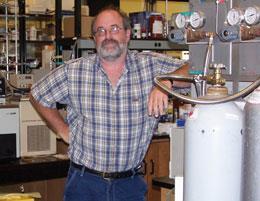Fluorochemicals are still causing concern. Emma Davies finds out how polar bears and microwaved popcorn reignited the contamination debate
Fluorochemicals are still causing concern. Emma Davies finds out how polar bears and microwaved popcorn reignited the contamination debate

The chemical industry is often plagued by negative headlines and the fluorochemical story is one with classic tabloid appeal - manmade chemicals found in Arctic polar bears and seals, and potentially carcinogenic chemicals in our homes and our food.
Away from the headlines, much has been done to take the sting out of the story. The potential health and environmental risks posed by some fluorinated alkyl compounds have been studied and companies and authorities have cut their production levels. Concentrations of some of the chemicals are already reported to be dropping in the Arctic.
But it is unlikely that this marks the start of the end of the horror stories. Debate still rages as to how the fluorochemicals are transported to remote regions of the globe and what the main sources are. On a more reassuring note there is still no conclusive proof that the chemicals cause harm to humans.
Frying pans and fabric spray
Fluorinated alkyl compounds have been manufactured for over 50 years but only in the past decade has their persistence in the environment come to the attention of researchers. The key offenders are the perfluorinated carboxylic acids (PFCAs) such as PFOA (perfluorooctanoic acid, often referred to as C8) and PFOS (perfluorooctane sulfonate). PFOA and PFOS salts are both industrial surfactants; PFOA is perhaps best known for its use in US chemical company DuPont’s Teflon products while PFOS was a key ingredient in 3M’s fabric protector Scotchguard.
Despite the lack of evidence that PFOS or PFOA harm human health, the US Environmental Protection Agency (EPA) is particularly concerned about PFOA, which it classes as a ’likely carcinogen’. It has no known metabolic or environmental degradation pathways and studies in rodents have shown it to cause tumours and damage to the immune and reproductive system, as well as having developmental toxicity.
Both PFOA and PFOS have been detected in human blood samples worldwide and are being picked up in growing numbers of animals, including Arctic polar bears, US dolphins and Chinese pandas. There are two current schools of thought as to how the chemicals are transported in the environment. Under the ’direct’ route, PFOA and PFOS released from manufacturing sites enter local water systems before travelling through oceans. Under the ’indirect’ or atmospheric route, volatile precursors from various sources are transported in the atmosphere before degrading to form PFOA and PFOS. Many believe that both mechanisms play an important role, but the theories have split researchers into two fiercely divided camps.
Poisoned ice

Work on fluorinated compounds in the environment has so far focused primarily on the Arctic, which has alarmingly high levels of PFOA. Scott Mabury, professor of environmental chemistry at the University of Toronto, Canada, has led much of this research, which points strongly to an indirect route for perfluorinated carboxylic acids.
Mabury’s team has pointed the finger of blame largely at the fluorotelomer alcohols (FTOH) used to synthesise fluorosurfactants and incorporated into a wide array of fluoropolymers. These are known for their non-stick properties and tolerance to high heat (Teflon or PTFE is probably the most famous fluoropolymer) and are widely used in the paper, carpet and textile industries. Industrial processes do not always incorporate all of the fluorinated alcohols and the so-called residual alcohols can be released to the environment. They are highly volatile and easily enter the atmosphere where they can then degrade to form carboxylic acids such as PFOA. Similarly, perfluoroalkyl sulfonamido alcohols (PFASs) are thought to be volatile PFOS precursors.

Tom Harner, an air quality research scientist at Environment Canada, Toronto, has measured concentrations of FTOHs and PFASs in the Arctic atmosphere, showing them to be ’abundant and widespread’. His data also suggest that FTOHs and related compounds can be transported over long distances in the Arctic.1
Chemical releases from industrial sites are not the only cause of concern - some consumer products also contain the precursor volatile alcohols. Last year, Mabury and Mary Joyce Dinglasan-Panlilio, also at Toronto, published a paper on loose, unbound fluorinated alcohols in finished consumer products, including carpet-protector sprays and windscreen washer fluid.2 They suggest that such alcohols could be a ’significant source’ of polyfluorinated telomer alcohols and sulfonamido alcohols released into the environment.
As well as adding to the environmental PFOA and PFOS burden, there is evidence that such alcohols could metabolise in the body to form the carboxylic acids. Mabury is looking into dietary sources of perfluorinated chemicals through food packaging and is currently working on fluorinated surfactants used in food contact paper. ’Our initial interest is in the fluorotelomer-based phosphates,’ he says. ’We dosed rats and showed that mono and di-phosphate surfactants are bioavailable and metabolised through all the well-known FTOH intermediates into PFOA.’
This adds a whole new dimension to the debate, says Mabury. ’The US Food and Drug Administration (FDA) assumed no movement from paper into food and that if the chemicals did move they would not be bioavailable.’
Harner is also interested in dietary exposure to related chemicals. He is involved in a Canadian study run from the University of British Columbia into perfluorinated chemicals in pregnant women, to assess whether they disrupt thyroid hormones and negatively affect foetal development. As well as giving blood samples, women will be asked questions about their diet, including whether they eat foods such as microwaved popcorn (the bags have high fluorotelomer concentrations). They will also be asked whether they use non-stick cookware and products such as stain repellents in the home. The final results will be out in 2008.
Harner and colleagues have measured high levels of PFASs in indoor air and dust in homes in Ottawa, Canada, concluding that ’indoor air and dust are an important human exposure route for PFASs’. Indoor air concentrations of two of the compounds, MeFOSE (N-methylperfluorooctane sulfonamidoethanol) and EtFOSE, were about 10-20 times greater than outdoor concentrations. However, the research ’didn’t find any striking correlations between things like carpeting and new furniture and chemicals in the home,’ reveals Harner. ’There are numerous sources for these chemicals. Our homes are acting like gas chambers - chemicals are volatilising and have no way of escaping.’
Worldwide regulation
Last year, the US Environmental Protection Agency (EPA) invited eight companies (Arkema, Asahi, Ciba, Clariant, Daikin, DuPont, 3M/Dyneon and Solvay Solexis) to take part in a voluntary programme to reduce levels of perfluorooctanoic acid (PFOA) by no later than 2010 and to work towards eliminating it by no later than 2015. Companies will submit their first progress reports this October.

The Canadian government has also taken significant steps against fluorochemical release. In December 2006, it proposed regulations to prohibit manufacture, use, sale and import of perfluorooctane sulfonate (PFOS) and its salts and compounds. Comments collected are being reviewed and the prohibitions will take effect once regulations are finalised. In 2004, the government prohibited four new fluorotelomer-based substances. Sandi Moser, Environment Canada, explains that the Canadian government is ’pursuing further assessment of other chemical substances already in use in Canada that lead to formation of perfluorinated carboxylic acids’. It is also seeking action from industry to reduce the unreacted or ’residual’ fluorotelomers that can be present in products. ’The government of Canada continues to work with the US EPA and other regulators to address this issue,’ says Moser.
Last year, European Union ministers and Parliament agreed on a directive to restrict severely the marketing and use of PFOS in the EU, which member states will have to enact in national law by mid-2008. The Commission aims to ensure that PFOS is phased out as soon as the use of safer alternatives becomes technically and economically feasible. It continues to review the PFOA situation. There is also talk of adding perfluorinated chemicals to the Stockholm Convention’s ’dirty dozen’ of persistent organic pollutants.
Direct action
It’s clear how widespread the fluorochemicals are but their exact mode of transport remains something of a mystery.

In January 2006, Ian Cousins from Stockholm University, Sweden, published a modelling study with DuPont which concluded that ’atmospheric and ocean water transport of the PFCAs themselves could significantly contribute to their long-range transport’.3 ’Up to then, everyone was talking about precursor compounds and how they were the major source of compounds in the environment,’ he recalls. ’When we did our calculations we found that manufacturing sources were far greater than the degradation of the precursors in the atmosphere. The difference was enormous.’
’If you look at where the chemicals are in the environment, they’re almost all in the oceans, which is not surprising - they are extremely water-soluble, anionic, and have a very low pKa which means they dissociate entirely.
He is fighting a battle against current scientific opinion. ’We’re trying to keep things as simple as possible at the moment so that people will believe us. We use a simple modelling tool that divides the world into five climate bands.’ Cousins considers both the direct and indirect transport routes important. ’It’s getting an understanding of relative importance that matters,’ he says. Mabury is outspoken in his rejection of the theory. ’It’s surprising how much mileage and profile the "direct route of contamination" theory has received, since to my knowledge there are no published data to support it,’ he says. ’The "indirect" route has a substantial amount of data that is consistent with it being a significant contributor. In fact some of this data directly contradicts the direct theory.’
In March this year, Mabury and colleagues published a paper suggesting that levels of perfluorinated compounds such as PFOS in Arctic ice have started to fall since 3M phased out PFOS production.4 This was supported by a temporal analysis of ringed seals from the Canadian Arctic carried out by a Mabury team, showing PFOS concentrations to increase steadily until 1998 or 2000, after which concentrations began to decrease. In Mabury’s view, this rapid decrease in PFOS levels following industry action points to an atmospheric transport route.
’It is important to define the context of the contamination,’ says Mabury. ’If we are talking about a river receiving waste water from a fluoropolymer plant then it is very clear that this is a major source of direct contamination to the receiving stream. Whether that source of contamination has anything to do with the very high levels observed in Arctic biota [seals, polar bears] is another matter entirely. I am unaware of any measurements that have been made to support this idea.’
Cousins concedes that the Arctic is indeed a different question. ’If you’re looking at snow on the polar ice cap there’s no doubt in my mind that precursors are the dominant source. But if you’re looking at water in the Arctic Ocean then I would say that we have to think again.’ He continues: ’Researchers tend to use Arctic lakes and snow to back up the theory that the major exposure route for polar bears and seals must be precursors. But I don’t think that follows.’
If Cousins’ direct transport theory is correct, it’s bad news for the environment. ’Even if emissions reduced to zero tomorrow, it will
take a long time for the environment to respond. We predict the concentrations of perfluorinated chemicals in the Arctic will continue to increase because there’s a time lag before they can start to decrease.’
Industrial action
US firm 3M was ahead of the game in phasing out fluorinated products. In 2000, it voluntarily halted production of perfluorooctanoic acid (PFOA), perfluorooctane sulfonate (PFOS; used in its Scotchguard product) and PFOS-related products including N-ethylperfluorooctane sulfonamidoethanol (NEtFOSE). By 2002 it had completed its phase-out of PFOS production and no longer makes or sells it, with one exception. One of its subsidiaries still uses PFOA to produce fluoropolymers, but has developed a technology to recover and recycle the chemicals and monitors the health of its employees.
3M claims that it took action not because of health concerns but because it ’did not want to add to the presence of this persistent compound in the environment or in people’. A company statement claims that ’studies continue to confirm that no adverse human health effects have resulted from exposure to PFOS or PFOA’.
Work by Scott Mabury’s team at the University of Toronto, Canada, suggests that the company’s action is already having an effect, with falling PFOS levels in Arctic ice. ’The data suggest, but are by no means definitive, that the cessation of PFOS-type chemistry by 3M, the major manufacturer, had a rapid impact on remote contamination of biota,’ says Mabury. ’This indicates that industrial or regulatory changes can have a positive impact.’

US firm DuPont, which manufactures Teflon, is the subject of a class action lawsuit after PFOA and related chemicals were found in drinking water near its Washington Works plant in Parkersburg, US. The company agreed to provide bottled water for residents living near the plant. Then, in February 2007, DuPont announced that it had made ’significant progress’ in developing products with reduced PFOA content. It has patented a new manufacturing process that removes more than 97 per cent of trace levels of PFOA in its fluorotelomer products using a thermal treatment. This process also improves product quality, explains David Boothe, global business manager at DuPont fluoroproducts.
DuPont has reduced PFOA content in aqueous dispersion fluoropolymer products using a post-treatment ion exchange process called Echelon which has now been installed in its commercial facilities. Boothe explains that DuPont is looking at ways not only to reduce and eliminate PFOA but also to improve products. Of the eight companies under the EPA scheme, ’everyone is trying to skin the cat better than the competition,’ says Boothe.
In from the cold
Work is moving on from polar bears to people. ’Since we have largely finished the experiments and measurements we could think of regarding the source of PFCAs to the Arctic, we are now focusing more on the route into humans,’ says Mabury.
Research in the field is spreading across the globe. The Global Atmospheric Passive Sampling (Gaps) network, which was set up to fill in information gaps on the spatial distribution of persistent organic pollutants, has picked up PFASs at most of its air sampling sites, reveals Harner, who is involved in the project. The next question for Gaps, he says, is to build up a global picture for the fluorotelomers to help modellers to validate and test models to see how the chemicals are being transported.
Within Europe, the Perforce project (perfluorinated organic chemicals in the European environment), is led by the University of Amsterdam, the Netherlands. When the project started, there were few data for perfluorinated organic chemicals (PFCs) in Europe, says Pim de Voogt, from the University of Amsterdam. ’We expected to find at least similar levels in Europe and that is indeed the case.’ The work highlighted a lack of unity in scientific methods used to pick up PFCs.
A follow-up study has been funded by the industry consortium Plastics Europe, allowing Perforce to continue for another year. One of its aims is to do another method performance study to improve the quality of methods of PFC analysis, says de Voogt. ’So far hardly any standards are available. We have synthesised PFCs and started testing an analytical protocol.’
Future of confusion
Lots of puzzles remain to be solved but it’s a field that fires up researchers. ’It’s a great thing to be looking into,’ says Cousins. ’These chemicals are a hot topic right now.’
The industry is taking no chances. Even amid all the scientific unrest and basic questions still unanswered, companies are voluntarily phasing out the chemicals and regulatory authorities are taking great strides to ban many of them. But the industry and opposing campaigning groups will be watching human studies closely waiting for news and the possible source of another media feeding frenzy. By that time, the hope is that these once valued chemicals will simply no longer be necessary.
References
1 M Shoeib et al, Environ. Sci. Technol., 2006, 40, 7577
2 M J A Dinglasan-Panlilio and S A Mabury, Environ. Sci. Technol., 2006, 40, 1447
3 I Cousins, Environ. Sci. Technol., 2006, 40, 32
4 C J Young et al, Environ. Sci. Technol., 2007, 41, 3455






No comments yet